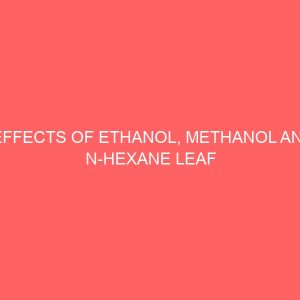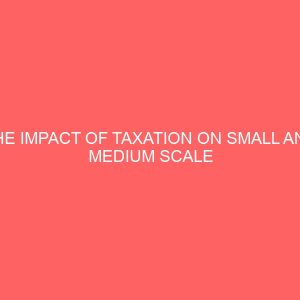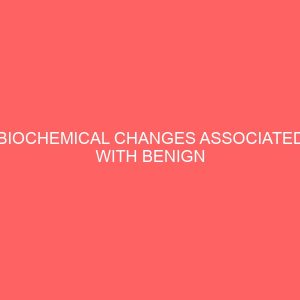Description
CHAPTER ONE
INTRODUCTION
This research is on Effects of ethanol, methanol and n-hexane leaf and fruit extracts of kigelia africana on some oxidative and biochemical parameters in alloxan-induced diabetic rats. Diabetes mellitus is a metabolic disorder resulting from a defect in insulin secretion, insulin action or both. Insulin deficiency in turn leads to chronic hyperglycemia with disturbances of carbohydrate, fat and protein metabolism (Kumar et al., 2011).
During diabetes, failure of insulin-stimulated glucose uptake by fat and muscle cause glucose concentration in the blood to remain high, consequently glucose uptake by insulin-independent tissue increases. Increased glucose flux both enhances oxidant production and impairs antioxidant defenses by multiple interacting non-enzymatic, enzymatic and mitochondrial pathways (Klotz 2002; Mehta et al., 2006). These include activation of protein kinase C isoforms (Inoguchi et al., 2000), increased hexosamine pathway (Kaneto et al., 2001), glucose autoxidation (Brownlee, 2001), increased methylglyoxal and advanced glycation end-product (AGEs) formation (Thornalley, 1998) as well as increased polyol pathway flux ( Lee and Chung, 1999). These seemingly different mechanisms are the results of a single process-that is, overproduction of superoxide by the mitochondrial electron transport system (Tushuizen et al., 2005). This hyperglycaemia-induced oxidative stress ultimately results in modification of intracellular proteins resulting in an altered function and DNA damage, activation of the cellular transcription (NFK B), causing abnormal changes in gene expression, decreased production of nitric oxide, and increased expression of cytokines, growth factors and pro-coagulant and pro-inflammatory molecules (Palmer et al., 1988; Evans et al., 2002; Klotz, 2002; Taniyama and Griendling, 2003). Oxidative stress is responsible for molecular and cellular tissue damage in a wide spectrum of human diseases (Halliwell, 1994), amongst which is diabetes mellitus. Diabetes produces disturbances of lipid profiles, especially an increased susceptibility to lipid peroxidation (Lyons, 1991), which is responsible for increased incidence of atherosclerosis (Guigliano et al., 1996), a major complication of diabetes mellitus . An enhanced oxidative stress has been observed in these patients as indicated by increased free radical production, lipid peroxidation and diminished antioxidant status (Baynes, 1991).
Globally, the estimated incidence of diabetes and projection for year 2030, as given by International Diabetes Federation is 350 million (Ananda et al., 2012). Currently available pharmacotherapies for the treatment of diabetes mellitus include oral hypoglycemic agents and insulin. However these drugs do not restore normal glucose homeostasis and they are not free from side effects (Bandawane et al., 2011). In view of the adverse effects associated with the synthetic drugs and as plants are safer, affordable and effective, conventional antidiabetic plants can be explored (Kumar et al., 2010). Over 400 traditional plants have been reported for the treatment of diabetes (Ramachandran et al., 2011). Furthermore, following World Health Organization recommendations, investigation of hypoglycemic agents from medicinal plants has become more important (Kumar et al., 2010). Also diabetes has been treated orally with several medicinal plants based on folklore medicine since ancient times.
Kigelia africana (Lam.) Benth (Family: Bignoniaceae) plant has many medicinal properties due to the presence of numerous secondary metabolites. These compounds include iridiods, flavonoids, naphthoquinones and volatile constituents (Houghton, 2002; Gorman, 2004; Asekun et al., 2006). Experimentally, the plant has shown antibacterial, antifungal, antineoplastic, analgesic, anti-inflammatory and antioxidant properties (Saini et al., 2009). Crude extracts of herbs and spices and other materials rich in phenolics are of increasing interest in the food industry because they retard oxidative degradation of lipids and thereby improving the quality and nutritional value of food. Flavonoids, are groups of polyphenolic compounds with known properties, which include free radical-scavenging and anti-inflammatory activities (Frankel, 1995).
An enhanced oxidative stress has been observed in diabetic patients as indicated by increased free radical production, lipid peroxidation and diminished antioxidant status (Baynes, 1991). In diabetes mellitus, alterations in the endogenous free radical scavenging defense mechanisms may lead to ineffective scavenging of reactive oxygen species, resulting in oxidative damage and tissue injury. Oxidative stress is currently suggested as mechanism underlying diabetes and diabetic complications. Oxidative stress may cause oxidative damage of cellular membranes and changes in the structural and functional integrity of sub- cellular organelles and many produce effects that result in the various complications in diabetic disease (West, 2000). Recently, there has been an upsurge of interest in the therapeutic potentials of plants, as antioxidants in reducing free radical induced tissue injury. Although several synthetic antioxidants, such as ascorbic acid, butylated hydroxyanisole and butylated hydroxytoluene are commercially available, they are quite unsafe and toxic (Viny, et al.,2010). A survey of literature revealed that there is no experimental evidence of the antidiabetic effect of Kigelia africana. Therefore, the present work explores this and will in addition study its potential effect on the oxidative and biochemical parameters of alloxan-induced diabetic rats.
- Kigelia africana
- Description of Kigelia africana
Nature has been a source of medicinal agents including modern drugs for the thousands of years (Cordell, 2000). Plant based traditional medicine system continues to play an essential role in health care with about 80% of the world’s inhabitants relying mainly on traditional medicines for their primary health care .
Kigelia africana (Lam) Benth of Bignoniaceae family is widely distributed in South central and West Africa. It is known as the cucumber or sausage tree because of its huge fruits (average 0.6m in length and 4kg in weight) which hang from long fibrous stalks. It is also known as Balm Khene in Hindi and is distributed all over India but found in abundance in West Bengal. It is found mostly in wetter areas and spread abundantly across wet Savannah and riverine areas (Sofowora et al., 1980). The plant grows approximately 10m high, with odd pinnate, composite opposite leaves; leaflets are ovate- to- oblong in shape and 4-18 cm long. The flowers are found in the spring or summer season, hanging ancillary panicles up to 2 m long. It has a corolla with fused petals, irregularly bell shaped 9-13 cm long, yellowish outside and purple on inside . Fruits are oblong, 30-50 cm long, hanging on stalk for several months.
- Taxonomy of Kigelia africana
Kingdom: Plantae
Order: Scrophulariales
Family: Bignoniaceae
Genus: Kigelia Dc-Sausage family
Species: Kigelia africana (Lam) Benth
Scientific name: Kigelia africana
- Traditional Uses of Kigelia africana
The Kigelia plant has medicinal properties with characteristics of bitterness and astringent. It has long history of use by African countries particularly for medicinal properties. Several parts of the plant are employed for medicinal purposes by certain aboriginal people. In Mali during famine the seeds are roasted and eaten. The baked fruits of K. africana are used for fermentation of beer. Most commonly traditional healers use it to treat a wide range of skin ailments like fungal infections, boils, psorasis, and eczema.
It has also internal applications including treatment of dysentery, ringworm, tapeworm, postpartum haemorrhage, malaria, diabetes, pneumonia and tooth care (Gill, 1992). The Tonga women of Zambezi valley regularly apply cosmetic preparations of kigelia fruits to their faces to ensure a blemish- free complexion (Pooleg, 1993). In folk medicine, the fruits of the plant are used as dressing for ulcers, purgative and for increasing the flow of milk in lactating women (Oliver-Bever, 1986). The roots are said to yield a bright yellow dye. The Shona people from India tend to use the bark or root as powder or infusion for application to ulcers, or in the treatment of pneumonia, as a gargle for toothache and backache (Maisiri and Gundidza, 1999).
In West Africa, the root and unripe fruit is used as vermifuge and as a treatment for haemorrhoids and rheumatism. The bark is traditionally used as remedy for syphilis and gonorrhea. The fruits and bark ground and boiled in water are taken orally or used as an enema in treating children’s stomach ailments – usu ally worms. The unripe fruit is used in Central Africa as a dressing for wounds, haemorrhoids and rheumatism. Palm wine exracts of leaf, bark and fruit extracts of the tree are used for treatment of venereal diseases (Walt el al., 1962).
- Chemical Constituents of Kigelia africana
- africana plant has many medicinal properties due to the presence of numerous secondary metabolites. These compounds include irridiods, flavonoids and naphthoquinones and volatile constituents (Houghton, 2002; Gorman et al., 2004; Asekun et al., 2006). Pinnatal and isopinatal were isolated from tropical trees that belong to the plant family of Bignoniaceae. Pinnatal was found in a root bark extract of the plant. Thin layer chromatography (TLC) examination of the most active fractions of both stem bark and fruits showed the presence of some major components which were found to be norviburtinal and B-sitosterol. Gouda et al.(2006) isolated a furanone derivative, 3- (21-hydroxyethyl)-5-(2” – hydroxypropyl)- dihydrofuran -2(3H)- one and four irridoids, 7 hydroxy viteoid II, 7 hydroxy eucommic acid, 1- hydroxyl – 10- deoxyecuommiol and 10-deoxy eucommoil together with seven known irridoids, jiofuran, jioglutolide, 1-dehydroxy-3, 4- dehydroaucubigenin, des-p-hydroxybenzoyl kisasagenol B, ajugol, verminoside and 6-trans-caffeoyl ajugol from the fruit (Gouda et al., 2003). They also isolated a phenyl propanoid derivatives identified as 6-p-coumaroyl-sucrose together with ten known phenylpropanoid and phenylethanoid derivatives and a flavonoid glycoside from fruits of K.africana (Gouda et al., 2006). The structures of the isolated compounds were characterized by different spectroscopic methods. Govodachari et al. (1971) isolated kigelin as the major constituent of the plant from the root heartwood.








